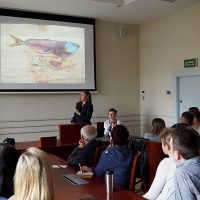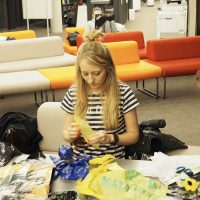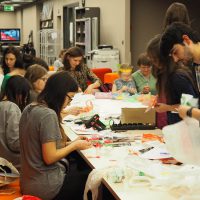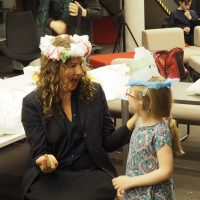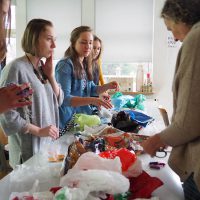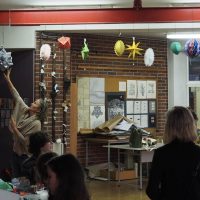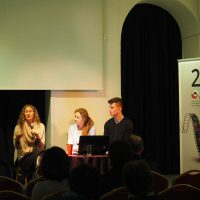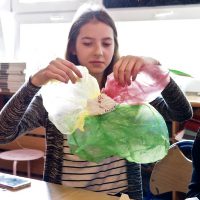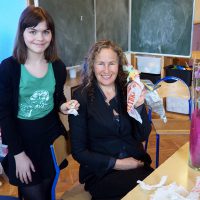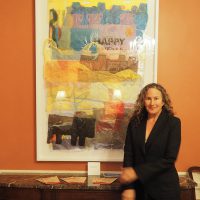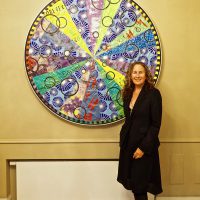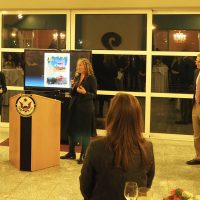In March of 2017, artist Dianna Cohen traveled to Poland to speak to and engage with art students and art professionals about her artwork and how it relates to her larger concerns regarding single-use plastics, like grocery bags, water and soft-drink bottles, drinking straws, and flatware. Cohen is a Los Angeles –based artist best known for her use of recycled plastic bags in her art. She cuts and sews the material like fabric, creating small hanging pieces, sculptures, and room-sized installations. Her work takes plastic originally created to be used once and then discarded and instead transforms the objects into art – to be esteemed and considered. The results, not unlike alchemy, are to take plastic bags – perceived to have little or no value and incorporate them into an enduring artwork that serves as a reminder to both maker and viewer of the qualities and origin of a material that can take hundreds of years to breakdown in a landfill.
Having worked with plastic over the years, Cohen began to recognize the material’s ubiquity and influence in her own life as an issue that needed to be understood and highlighted. Her artistic practice has expanded to include social engagement, and, in 2009, Cohen co-founded the Plastic Pollution Coalition, a global alliance working toward a world free of plastic pollution and its toxic impact on humans, animals, and the environment. In 1999, Cohen first exhibited through Art in Embassies when two works Disposable Sin, 1998, and Maya, 1995, where shown in the U.S. Ambassador to Namibia’s residence in Windhoek. Over the years, Art in Embassies has included her work in in San Salvador, and she is also represented in the permanent art collection of the Tijuana Consulate.
Cohen’s work Happy Fabulous, 2010, had been included in the recent Art in Embassies exhibition in Warsaw at the Residence of U.S. Ambassador Paul W. Jones and Catherine Jones. The show includes a selection of American artists who also create art from plastic and other ‘throwaway’ materials. The six artists are Gyongy Laky; Virginia Fleck; Amy Eisenfeld; Dianna Cohen; Annie Farrar; and Sheila Gallagher. While sharing methods and materials, each of their works is unique in intention, execution, and final outcome.
Ambassador Jones and his wife invited Cohen to Poland to conduct a series of artist workshops and presentations to schools, universities, museums, environmental organizations, media outlets, and the general public. During her weeklong trip, she visited the cities of Krakow, Katovica, Radon, and Warsaw. At the University of Agriculture in Krakow, Cohen met with faculty members and Dean and then gave a talk to graduate students from the Department of Agricultural Environmental Protection. Cohen also gave a public talk and workshop at the Arteska Wojewodzkiej Biblioteki Publicznej – the regional public library’s space devoted to arts and culture in Krakow. She also lectured and screened videos as part of a Meet the Artist series at Bunkier Sztuki Gallery of Contemporary Art.
With the support of the American Corner in Radom, Cohen gave presentations of her artwork, screened and shared in dialogues following through Q&A’s at two locations — Łaźnia Gallery Radom and the larger venue Łaźnia Concert Hall Radom – to diverse audiences including university students, artists, environmental activists, and the general public.
Cohen also engaged with students at an arts high school –the Zespół Szkół Plastycznych w Katowicac—in the industrial city of Katowice as well as an art class of young, elementary-age students at the Lotników Amerykańskich School in Warsaw. At these workshops, attendees knew in advance to bring in single-use plastic bags as the medium to create their own art. The workshops began with an introduction by Cohen on her artwork and her subsequent activism. Using images of her artwork to illustrate the aesthetic possibilities of a material more likely to be discarded than displayed as art, Cohen offered guidance and support to workshop participants. At the workshops, familiar tools like scissors, thread, sewing needles, and a hot glue gun, were available. The bags were then cut, glued, collaged, braided, and/or sewn into artworks. At the end of each event, Cohen collected the artworks made at these workshops to later include and assemble into a larger artwork to be made by the artist.
Cohen’s visit to Poland concluded with an Evening Reception introducing the Art in Embassies exhibtition of art at Ambassador’s Residence. Additionally, an event, Trash Orchestra- Music Waste, was held as a free music concert/ artists’ performance at Fort Sokolnickiego in Warsaw. Inspired by Cohen’s artwork re-using plastic, the musicians composed a work to be performed using traditional musical instruments as well as instruments made of materials like garbage cans, plastic containers, foil, aluminum, glass and plastic bottles, cardboard boxes, and garbage trucks. Cohen described the event as “extraordinary and wonderfully playful, at times psychedelic and full of contemplation and positive momentum.”
Considering her Artist Exchange to Poland, Cohen confirmed that Art in Embassies is “a very elegant, beautiful and peaceful form of cultural diplomacy and is critical today now more than ever. When political tensions escalate, art persists and exists as a language to share love, harmony, peace, sadness, death, pain, joy and happiness; with personal interpretations, art is a form of communication which transmits the truth at times with honesty and efficiency. Art is pure expression.”
